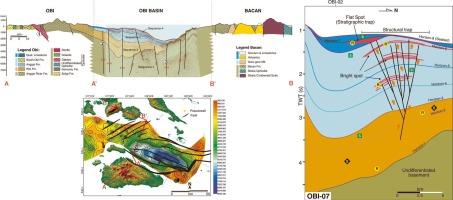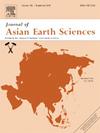印尼北马鲁古欧比盆地构造地层演化及其油气勘探潜力
IF 2.4
3区 地球科学
Q2 GEOSCIENCES, MULTIDISCIPLINARY
引用次数: 0
摘要
欧比盆地是印尼东部的前沿盆地之一,被划分为海洋盆地,被认为具有较差的石油潜力。然而,构造地层学研究表明,该区具有较厚的沉积演替,显示出活跃的含油气系统。索荣断裂横贯盆地,对盆地发育、沉积充填、油气生成和运移路径产生重要影响。利用地震和地质资料,确定了欧比盆地的4个层序。层序1为古近系昂盖河组火山碎屑岩,形成于澳大利亚板块俯冲至菲律宾海板块之下,具有较古老的变质岩和蛇绿岩。中新世早期的碰撞导致了盆地隆升和层序2 (Fluk灰岩和页岩)的沉积。中新世中期摩鹿加海在Halmahera下的东俯冲结束了第2层序,以火山碎屑岩和Guyuti组和Woi组浅海沉积为标志。此后,上新世哈马黑拉-桑吉河弧碰撞引起大抬升,导致3层序(南奥比火山碎屑岩和昂盖碳酸盐岩)快速沉积。由于均衡作用,随后的下包裹开始了第四层序浊积岩的沉积。在含油气系统方面,层序1为经济基底,层序2为成熟烃源岩。层序2、3、4为粗、细层序互层,具有储层和封闭层序的双重潜力。索荣断裂的运动与摩鹿加海的俯冲相吻合,形成了四向倾闭背斜,形成了构造圈闭。本文章由计算机程序翻译,如有差异,请以英文原文为准。

Tectonostratigraphic evolution of the Obi Basin, North Maluku, Indonesia, with implications for petroleum exploration potential
The Obi Basin, one of the frontier basins in Eastern Indonesia, is classified as an oceanic basin and is believed to have poor petroleum potential. However, our tectonostratigraphic study reveals a thick sedimentary succession with indications of an active petroleum system. The Sorong Fault, which traverses the basin, significantly impacts the basin development, sedimentary infilling, petroleum generation, and migration pathways. Four rock sequences in Obi Basin were defined using seismic and geological data. Sequence-1 comprises Paleogene volcaniclastic of Anggai River Formation, deposited during the subduction of the Australian Plate beneath the Philippine Sea Plate, with older metamorphic and ophiolitic rocks. Subsequent collision in the Early Miocene led to basin uplifting and deposition of Sequence-2 (Fluk limestone and shale). The Middle Miocene eastward subduction of the Molucca Sea beneath Halmahera ended the Sequence-2, marked by volcaniclastics and shallow marine deposits of the Guyuti and Woi Formations. Afterward, Pliocene Halmahera-Sangihe arc collision caused major uplift, leading to rapid deposition of Sequence-3 (South Obi volcaniclastic and Anggai carbonate). A subsequent down-wrapping due to isostasy initiates the deposition of Quaternary turbidites of Sequence-4. In terms of the petroleum system, Sequence-1 is considered an economic basement, while Sequence-2 is identified as a mature source rock. Sequences-2, 3, and 4 exhibit interbedded coarse and fine sediments, which have the potential to be both reservoir and seal rocks. The movement of the Sorong Fault coincided with subduction in the Molucca Sea, creating four-way dip closure anticlines that serve as a structural trap.
求助全文
通过发布文献求助,成功后即可免费获取论文全文。
去求助
来源期刊

Journal of Asian Earth Sciences
地学-地球科学综合
CiteScore
5.90
自引率
10.00%
发文量
324
审稿时长
71 days
期刊介绍:
Journal of Asian Earth Sciences has an open access mirror journal Journal of Asian Earth Sciences: X, sharing the same aims and scope, editorial team, submission system and rigorous peer review.
The Journal of Asian Earth Sciences is an international interdisciplinary journal devoted to all aspects of research related to the solid Earth Sciences of Asia. The Journal publishes high quality, peer-reviewed scientific papers on the regional geology, tectonics, geochemistry and geophysics of Asia. It will be devoted primarily to research papers but short communications relating to new developments of broad interest, reviews and book reviews will also be included. Papers must have international appeal and should present work of more than local significance.
The scope includes deep processes of the Asian continent and its adjacent oceans; seismology and earthquakes; orogeny, magmatism, metamorphism and volcanism; growth, deformation and destruction of the Asian crust; crust-mantle interaction; evolution of life (early life, biostratigraphy, biogeography and mass-extinction); fluids, fluxes and reservoirs of mineral and energy resources; surface processes (weathering, erosion, transport and deposition of sediments) and resulting geomorphology; and the response of the Earth to global climate change as viewed within the Asian continent and surrounding oceans.
 求助内容:
求助内容: 应助结果提醒方式:
应助结果提醒方式:


